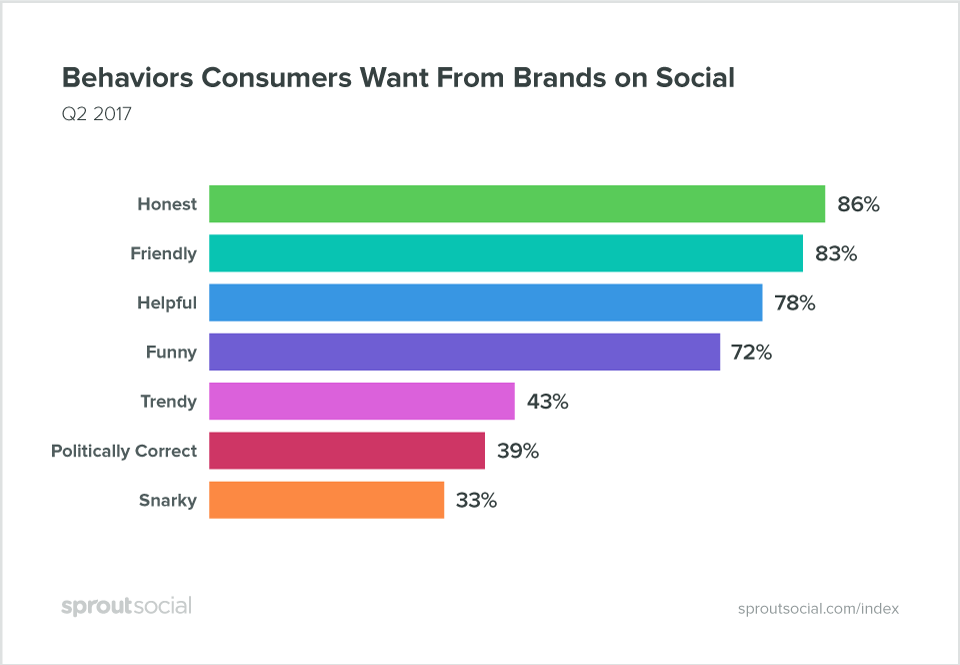Every time your business launches an advertisement, updates website copy, speaks at a conference or posts on social media, you showcase your brand voice. Whether you stick to your core brand voice depends on how well you developed it in the first place.
Just like you would concept several designs for your brand logo, it’s smart to define and strategize your voice. Because in a perfect world, everyone would recognize your logo without any content. But we know that’s not the case for most brands out there.
This means companies have to rely on building a brand voice on platforms like social media to help distinguish themselves from every other brand. So how do you achieve this without scraping all your ads and copy?
Get everyone on the same page. Here we’ll go over five simple ways for your business to define and maintain your brand voice:
1. Reinforce Your Brand’s Beliefs
What does your CEO or founder repeat over and over again? How do you want your customers to perceive you? Are you a funny company?
These questions are challenging, but you should–more importantly need to–have a good idea. If not, it’s time to go back to the drawing board and get clear answers from your leaders. For the rest of us, the first step toward defining your brand voice is to reinforce your beliefs.

Sprout Social’s Q2 2017 Index discovered consumer’s most sought-after behavior from brands is honesty. And probably to very little surprise, consumers least favorite behavior is a snarky attitude.
The point here isn’t to say being snarky doesn’t convert customers. In fact, many will point out brands like Wendy’s, MoonPie or Hot Pockets see plenty of engagement by “talking back” to followers on social.
However, does this tone and messaging match your company’s beliefs? It’s all about creating parallel experiences. By maintaining your fundamental beliefs across content, advertising and social media posts, you create similar experiences. These recognizable actions help drive people through your marketing funnel.
They also create expectations for customers. If you mix your messages, you become unreliable. Sprout Social’s Q1 2017 Index found similar themes. In fact, the report discovered what drives millennials to unfollow brands on social is a bad experience and annoying behaviors.

Start by reinforcing your core values so you know your brand voice promotes the same message and continuity across all channels.
2. Thoroughly Outline Your Ideal Brand Voice
If you’re still fully deciphering your brand voice, it’s smart to dissect and outline all your variables. When everyone knows exactly how your brand communicates, tweets and Instagram posts suddenly become easier to develop.
Did you know that 71% of consumers have unfollowed a brand on social because they were embarrassed? Not only that, but 41% admitted to unfollowing brands who don’t share relevant information.

Keeping customers happy while informed is a tricky balancing act for brands. This means you need to maintain a clear voice right from beginning. Otherwise, you’re going to annoy, confuse or upset your audience and drive away customers.
Try these few exercises to create a clear outline:
- Storyboard your voice: Storyboarding is a great method for writers to develop a character in a story or script. Figure out everything your brand does and doesn’t like, end goals and who your brand wants to be. This could help you define your voice with even more precision.
- Have a social customer service strategy: Do you know what to say when an angry customer hits you up on Twitter? Is it more than just a “sorry to hear that,” or are you directing them to your customer service number? Ensure all your responses and interactions have the same goal, and prepare your team to answer any question that arises on social.
- Detail your social jargon or colloquialisms: Does your brand speak frankly on subjects? Does your audience understand the relaxed or professional jargon you use? Make sure you don’t have one person posting Facebook statuses that use professional buzzwords, while another uses casual or colloquial language.
A Better Way to Manage Social
A Better Way to Manage Social
3. Avoid Bait & Switch Communication
This tactic might seem obvious, but it’s actually very easy to speak to your customers one way, but send them down your funnel with different language. A report from Contently found more than 66% of people have felt tricked by a brand for a sponsored article, video or other paid content.
It’s far too easy to deceive your customers with paid content, which means you should avoid any bait and switch methods. For example, if you’re promoting a major sales event on your Instagram, keep the messaging clear and consistent across other channels.
Additionally, if your company believes in providing the freshest ingredients or making products in the US, make sure your audience knows. Don’t make it hard for users to find information on your products if you promote sustainable or organic items.
Reinforce your brand’s beliefs with social media content that is relatable, reliable and easy to digest for whichever social media channel you choose. This is especially true for brands that are trying to get customers to go from online interaction to in-person sales.
4. Monitor Your Audience Engagement
Like we mentioned before, each time you reply to a message, post a status update or upload a video, you’re pushing your brand voice. And on social media, users come to you with questions and concerns, which means you have to maintain that brand voice when responding.
According to an Oracle report, 43% of social media users only interact with brands to get a direct response to a question or issue. This makes total sense. People want their concerns prioritized and nobody wants to wait on the phone to speak to a representative.

While replying to all of these conversations might seem like too much work, there are social monitoring tools to help your efforts.
Sprout Social’s suite of social media monitoring tools is specifically for brands who need to address, divide and distribute social messages to the right person. Our Smart Inbox allows message tagging to let teams work faster and prevent bottlenecking with departmental questions.
Even if you’re not tagged in the message, there are opportunities to make your brand’s voice shine. In fact, the previously mentioned Sprout Index found only 1 in 10 social media messages get a response.

Listening and monitoring your messages gives you the chance to make a real impression on a customer. While response rates change per industry, increasing actions and availability can have serious payoffs.
5. Learn Where Your Brand Voice is Highlighted the Most
Not only is it smart to know your brand’s tone, but also recognize where it is highlighted the most in your company. When your brand voice is used through the right channel, you increase your influence.
Some of the most popular places where your brand voice is highlighted on social media include:
- Replies: All brand replies should have the same context as other important messages. Determining your brand voice in advance helps you know the exact tone in which to reply to any comments on social.
- Calls to action: Your calls-to-action on social media must also maintain the same brand voice as everything else. Don’t switch tones with your CTAs and landing pages as it can put off your readers. Use CTAs that match your company’s beliefs. You’d be surprised what one-to-three words can do.
- Instagram captions: On Instagram, you have the ability to draw in your audience with creative captions or things like emojis. Instagram is certainly the place to showcase your brand’s creative side, but make sure your captions match anything that would be on your company’s website or other documents.
- Direct messages: With emphasis on social customer service, you need to ensure your direct messages are answered with the utmost care. If your brand voice is supposed to be trusted and professional, DMs with jokes or relaxed text could standout.
- Bios: Your social media bios are the best space to showcase your brand voice. It doesn’t need to be humorous or stern, but simply you. This is how many consumers will first see you, so make sure your bios are well-written.
- Visuals: Your brand’s voice can be detected in visual content as well. Always make sure your visuals still lead back to your own brand.
Learn how to tailor your brand’s voice to reach a larger audience without compromising your message.

Be Proud of Your Brand
With so much commotion on social media, it’s hard to stand out. But it’s a lot easier to create a bad or forgettable experience that will leave your customers flocking for the unfollow button.
However, when businesses develop and stick to a brand voice, social media interactions suddenly get easier. Make sure you work to promote your brand voice and have a clear vision of how everyone sees your brand.
